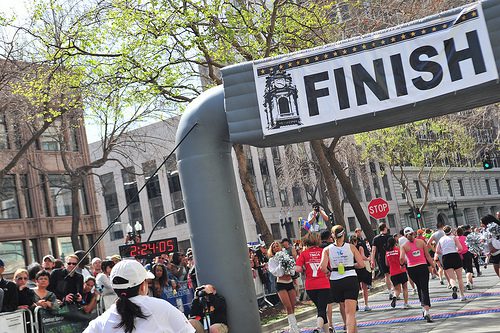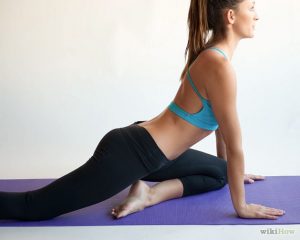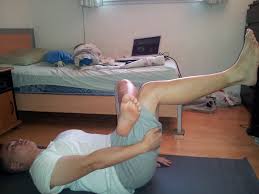
It’s early in the training season, and you’ve got the Oakland Running Festival on your mind as one of your goal races. Whether you will be running the Oakland marathon, half marathon, relay, or 5k, you NEED to be doing these exercises in order to prevent knee pain, hip pain, and other running injuries. Most running injuries are preventable, and NOW is the time to start these five sets of exercises, in order to have the most enjoyable experience during the Oakland Running Festival.
Aside from stepping wrong off a curb, colliding with another runner, or tripping on something along the course, the majority of the running injuries that crop up during the Oakland marathon or half marathon (or even during training season) are repetitive use injuries. The sport of running requires repetitive motion of the hips, knees, and ankles, and if any of your joints are misaligned, fixated, or restricted in motion due to soft tissue adhesion, your biomechanics become altered and you end up with overworked and painful muscles at the location of your weakest link.
There are four primary factors that will keep a joint from moving properly. Keep in mind that if one joint doesn’t move properly, another joint will move too much thanks to our bodies’ unique ability to compensate for dysfunction. Once an area starts moving more than it is designed to, excess pressure, friction, and tension build up, leading to decreased circulation, inflammation, and dysfunction. These four factors are:
1. Fixation of a joint.
2. Weakness of a muscle that affects joint biomechanics.
3. Soft tissue restrictions (adhesions) in muscles that move a joint.
4. Misalignment of pelvis or spinal vertebrae.
Factors 1, 3, and 4 are best addressed by a chiropractor, but factor 2 you can take preventative action on NOW! The exercises presented below are the most effective exercises to strengthen the hips and glutes, which are the power-movers of our legs. Most knee pain in running is caused by either weak glutes, fixation or misalignment in the pelvis, soft tissue restriction in the external rotator (hip) muscles, or a tight psoas muscle “turning-off” the gluteal muscles. Get a jump on glute problems now, before you feel any pain…you will thank yourself the day after the Oakland Running Festival! There are five types of exercises presented here: stretching, strengthening, self-myofascial release, dynamic stretching, and joint mobilizations.
With five exercises in each category, it may seem overwhelming, but we can break it down into smaller segments. Just make sure you incorporate the dynamic stretches listed here into your warmup routine, and then after your run, cool down with the static stretches. Pick a few evenings (or whatever time of day you can commit to) a week to do your joint mobilizations and foam rolling. Once you become familiar with these exercises, you can often work them into your everyday activities. Some people like to take care of phone calls (on speaker) while foam rolling, others create fun family activities around joint mobilizations (kids love to try spiderman pose, lizard pose, or really anything with an animal in the title). The biggie is usually the strength exercises, but they are probably the most important of all these types of exercises, so make time for them! Go to the gym if you need to use the equipment there, purchase some dumbbells if your best chance of fitting in these exercises is to work out in your living room. Plan ahead for success!
The most effective stretches for runners
1. Figure 4 or pigeon stretch
Pigeon stretch allows for deep relaxation and stretching of the gluteal muscles, specifically the deep external rotators. NOTE: If you have an entrapment of the sciatic nerve at the piriformis or at one of the lesser recognized external rotators, this stretch may actually aggravate your sciatica, and should be avoided until you’ve visited an Oakland sports chiropractor who specializes in sciatica.

Figure 4 stretch is an alternate version of pigeon that may be performed lying on your back, and which is often less strenuous on the knee joints. With bent knees and soles of feet on mat, cross your right ankle over your left knee. Thread your hands through and grasp the back of your left thigh. Guide that thigh into your chest to deepen the stretch. Dorsiflex both of your ankles to protect your knees!
2. Psoas and rectus femoris stretch
Stretch out your tight hip flexors with this variation of runner’s lunge. Shift your body weight forward, and increase the stretch through the front of your rear thigh by scooping your pelvis under and up (posterior pelvic tilt). Holding a static stretch like this for 30 seconds is long enough to allow for muscle relaxation and restoration of the normal muscle length.
3. Calf (gastroc and soleus)
Stand facing a wall, step one foot back, plant that heel on the ground, and lean into the wall keeping your back leg straight. This targets the gastrocnemius muscle, and other main calf muscle (the soleus) can be targeted by bending the knee of your back leg, while still keeping your heel on the ground.
4. Hamstring stretching (you may be doing this wrong!)
When you think of hamstring stretching, do you picture a runner haphazardly whipping his leg up onto the closest bench, pressing his heel into the bench, and leaning forward? This is the most common method used to stretch the hamstrings, but it\’s also one of the most common exercises that runners perform incorrectly. Once you get your heel supported, think about tilting the top of your pelvis forward. This lengthens the hamstring, and brings the stretch into the hamstring, and out of the vulnerable lower back! Once you get that forward tilt, lean forward only as far as you can before you feel your lower back round. You may be surprised at how little lean it actually takes to stretch your hamstrings!
5. Iliotibial band stretch
Cross one straight leg over the other while standing, and then bend forward and reach for your toes. You may need to shift your hips a few inches to the side to feel this stretch, but once you feel it, it can be pretty intense.
The most effective strengthening exercises for runners
1. Squat and squat variations. Your basic squat can be performed using dumbbells held at shoulder height or with a 45 pound bar resting on the shelf formed by your trapezius muscles (don\’t make the mistake or resting the bar on the base of your neck). As you lower down, imagine you are aiming your butt for a chair seat, which means it will translate backwards in space. Many people will just bend their knees without sending the hips backward, which makes you end up in a dangerous position with your knees caving in towards each other and shifted forward of your toes. If you feel like you\’re going to tip backwards as you approach the bottom of your squat, you\’re doing it right, and just remember that the weight will counterbalance you. If you feel like it\’s impossible to get your hips low enough, your ankle dorsiflexion is likely limited (see below for joint mobilization exercise 1.)
A common variation of the squat is called air squats, which are typically performed at high repetitions with only bodyweight in order to train the quad and glute muscles until fatigue.
Another good variation is the Bulgarian split squat. As this type of squat requires an advanced level of strength and coordination, it\’s crucial to perform it with proper form. The most important thing to look for is the position of your front knee in relation to your ankle. If you were to look from above, your knee should not be tracking forwards of your ankle (that is, you should be able to see your toes). You need to work backwards from that point in order to properly setup the distance between your front and back foot. Your back foot is supported on a workout bench or chair, and you\’ll want it a comfortable distance behind your front foot. This video walks you through proper setup and form.
2. Deadlift
The deadlift is a great exercise that works the whole posterior chain: that is, the hamstrings, glutes, and back muscles. Runners have a tendency to become quad dominant, so the deadlift is a good exercise to restore some balance to the body and get the glutes and hamstrings working efficiently. There are several variations including the Romanian deadlift and the straight leg deadlift. This video shows how to use proper form while doing a deadlift.
3. Lunges
Forward lunges, backward lunges, cross-over lunges, pendulum lunges…there are as many lunge variations as there are new running routes to try. Livestrong.com has a good video series on various types of lunges. For some ideas, try this video (front lunges) and this video (side lunges). The important consideration with lunges is to keep your front knee tracking over your front ankle. Don\’t let your knee cave in towards the midline of your body!
4. Good-mornings
This one is another fantastic exercise to strengthen the primary movers: the gluteal muscles! These are similar to deadlifts, but are often easier to perform in terms of getting your form dialed in. The personal trainer in this video has impeccable form and clearly talks you through how to correctly perform this exercise.
5. Core work
Planks, and their many variations, work your abdominal muscles, your gluteal muscles, and the stabilizing muscles of your back. This video shows just a few of the possible variations.
The most effective joint mobilization exercises for runners
1. Standing wall ankle mobilizations
2. Tactical frog, both variations
3. Three point thoracic rotation mobilization
4. Spiderman aka lizard pose
5. Thoracic extension over a foam roller
Lie on your back with the foam roller placed perpendicular to your spine at the most rounded area of your upper back (this is right at the shoulder-blades for most people). Touch your fingertips to your forehead, and then touch your elbows together. Maintain this contact as you extend your spine back over the foam roller on your inhale. On your exhale, rise back up to the start point. Repeat six times, moving as slowly as you need to in order to enjoy a full inhale over the roller and full exhale back. Depending on the length of your spine, you may need to scoot up or down an inch or two to make the fulcrum point more comfortable and effective.
The most effective dynamic stretches for runners
Runner\’s World has some great information about dynamic stretching. See this link for more examples. Our video shows the first four of the dynamic stretches prescribed below.
1. Hip, shoulder circles
2. Standing torso twists
3. Walking lunges (not full ROM)
4. Jumping jacks
5. Heels to butt and high knees
The most effective self-myofascial release exercises for runners
1. Tennis ball under foot (even if you don\’t have plantar fasciitis)
Standing barefoot, place a tennis ball (or one of these grippy Yoga Tune Up balls) on the floor underneath your right foot. Begin with most of your weight into your left leg, and then start to incrementally shift some weight into your right leg to increase the amount of pressure that you feel on the bottom of your right foot. You will know you\’ve found your limit when it\’s not exactly painful, but definitely less than comfortable! Maintain this tension, and roll your foot around so that you feel the ball massaging the tender spots near your heel, at the balls of your toes, and everywhere in between. This mechanical pressure breaks up pesky trigger points in your plantar fascia (the tough connective tissues along the sole of your foot) and in your superficial and deep foot muscles.
2. Foam roller or tennis ball in external rotators of the hip
Sit on a foam roller (sit lengthwise…if you were to reach your hands out to your sides, the long axis of the foam roller would be in the same plane) with the soles of your feet on the floor and bent knees. Plant your hands on the floor just behind the foam roller for stabilization. Cross your right ankle on top of your left knee similar to the figure 4 stretch above, and then lean to your right. From there, you can roll a bit forward and back to find any tender/tight areas. When you find a tender spot, maintain pressure on it for about thirty seconds. In most cases, the tenderness will dissipate as you hold pressure. Make sure to switch the cross of your legs and direction of your lean in order to address the muscles of your left hip and glute. In this exercise, we are addressing the muscles of the glute max and the external rotators such as the piriformis.
If you feel that you can\’t generate enough pressure using the foam roller, instead sit on a tennis ball and roll until you find a tight spot. There are many different ways to do this, but my personal preference (for trigger points on the right side) is to straighten my right leg and keep my left leg bent with the sole of my foot on the ground. This allows me to generate some force using my left leg while keeping my right gluteal muscles relaxed. Play around with what works best for you. The only caution here is to stay off the sciatic nerve. You will need to get close to it to address adjacent musculature, but when you feel a \”zingy\” or sharp nerve pain, just roll half an inch to one side and you should feel that you are clear of the nerve.
3. General spinal rolling on foam roller
Lie on your back with the foam roller placed perpendicularly under your mid-back. Support the back of your head in your hands, and then push through your heels to lift up your hips. Allow your head to lower back over the roller as your hips raise up and you feel the roller working higher on your back. Then reverse the motion and notice the roller is now working lower on your back. There\’s no one correct way to do foam rolling, other than avoiding positions that bring you obvious discomfort. The general idea is to get your body positioned in an ideal position so that your body-weight provides enough pressure against the foam roller for it to feel like a nice self-massage. Avoid spinal foam rolling if you have spinal stenosis or if you feel any shooting pains. Slender people and/or people with a more prominent spine sometimes have better luck crossing their arms and giving themselves \”a hug\” and rolling the muscles along one side of their spine at a time.
4. Adductor (inner thigh) release
This isn\’t so much a difficult exercise as one that is oft forgotten. We\’re always thinking about our tight hamstrings and glutes, but the adductors get just as tight because they are always working as stabilizers and they never get any attention! Don\’t go overboard and use one of those knobbly rollers- that\’s just asking for discomfort. Lie face down, support yourself on your forearms, and bend your right knee to ninety degrees so your whole right inner leg is facing the floor. Slide the foam roller under your inner thigh so that it\’s long axis is perpendicular to your thigh. Use your forearms and your left toes to move your body from side to side so you can cover the whole length of the adductors.
You can safely roll the entire length of your adductors from your inner knee up to your groin, with one caution. There is a spot called the adductor hiatus (about four inches up from your knee) which is very sensitive to pressure. It\’s a passageway for a large set of arteries, veins, and nerves which emerge from the thigh to travel into the lower leg. You will likely naturally avoid this area since it can be so sensitive.
5. Seated hamstring on a tennis ball with added knee flexion/extension
Sit on a bench or chair that is tall enough to allow you to bend and straighten your knee without your foot catching on the floor. Choose a chair that is not very cushy since this exercise won\’t be effective if the tennis ball sinks into the chair. Place the ball underneath any one of the tight spots you feel in your hamstring. Slowly extend your knee so your leg straightens, and then slowly re-bend your knee. The ball shouldn\’t leave its position between the chair and your hamstring. This adds a dimension of active movement to an otherwise passive exercise.
We hope you have a great experience at the Oakland Running Festival. If you have any questions about these exercises or come up against any bothersome injuries that won\’t quite shake themselves off, please give us a call at (510) 465-2342. We\’re here to support you in your running adventures. Here\’s hoping for good weather on the big day! Now go Run Oakland!
